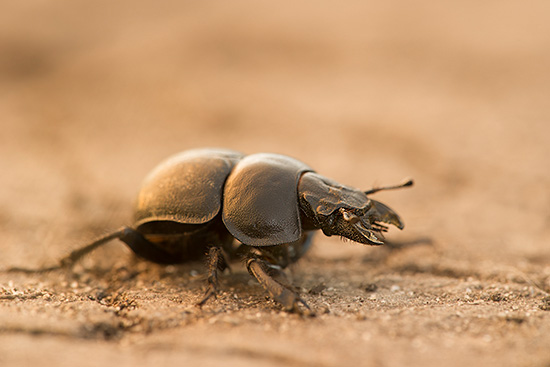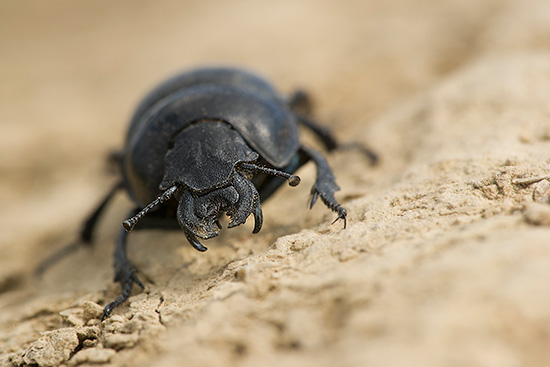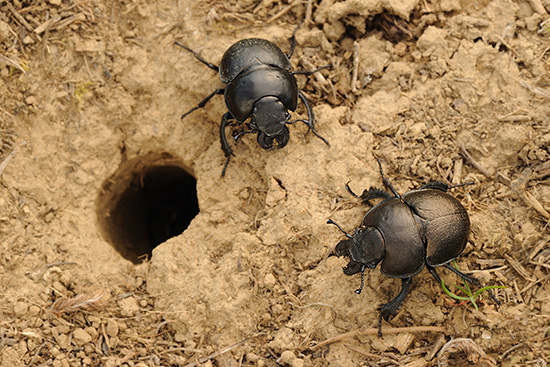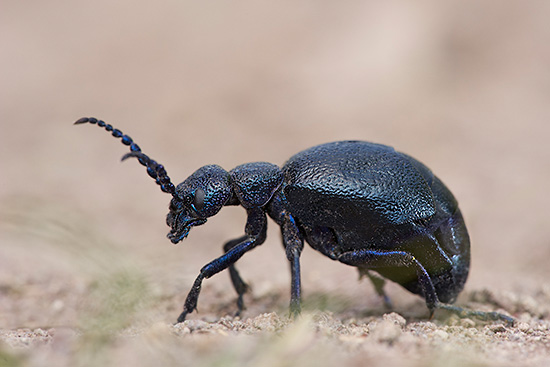'Big, fat and ugly, but fascinating'. A dung beetle species, who clearly meets these characteristics is ‘Lethrus apterus’. Thanks to accurate site information from our Hungarian friends Nikola Rahmé and Sándor Bérces, we were able to observe this fascinating creature in its natural habitat in the hills north of Budapest.

Ecological background: Lethrus apterus is a large blackish dung beetle, with a huge widened head and a large thorax. It is a stenotopic species (which means it is restricted to one or a few related habitats), and is unable to fly. Lethrus apterus is a thermophilous, Ponto-Pannonian species, which has become increasingly rare due to habitat loss and destruction. It is found in extensively grazed vegetations and fields on heavy loam and clay soils, in which it digs an up to 45 cm deep tunnel. It feeds on young shoots of plants, including vines. The male guards and defends the tunnel and brings the female and the larvae food. Despite the fact that the species has become highly localised in Europe, it can still be locally abundant when the ecological conditions are favourable. The species used to be a pest species in ancient times, causing severe damage to fields and vineyards.
On 11 April, during a chilly morning, we found in Csobanka a field where the soil was scattered with deep, solidly built holes in the ground. Most of the holes were almost vertical and had a diameter of about two centimetres large. So this was definitely the place to be. But after about half an hour slowly screening the vegetation I had only come across dead specimens of Lethrus and Dorcadion aethiops. The previous days had been ideal for beetle activity with a temperature of 25 degrees. Now it was cold, clouded and very windy. During this time of the year most of the female Lethrus are in their burrows, where the eggs have been laid in an ovoid chamber. This chamber is located at the end of a lateral tunnel, where the male brings leaves as the larval food source. When it is warm enough, the males are often found in the close vicinity of the entrance of the tunnel in search for food or guarding the entrance.
Luckily around noon, the sun pierced through the clouds and it started to warm a little bit up. I soon found some males which had left the tunnel. Under here an image of a male.

Although the majority of the beetles I found were males, I could observe a few females as well. The female is often slightly bigger (about 20 -24 mm) and has a little more brownish colour. Under here, an image from a female.

The easiest way to distinguish a male is his ‘forked jaw’, which can be seen on the image under here.

After a few hours of sun, more and more dung beetles had left their holes and were active. We were blessed with some spectacular activities of fighting males. They were trying to make their opponent back off by pushing him with their massive head and jaws backwards. They looked like miniature sumo wrestlers. Another very funny type of behaviour is that when we approached a male too close, it almost always walked backwards towards its hole to disappear backwards in it.
Under here an image of both the male (above) and female (right under) sitting close to their burrow.

Oil Beetles
On the same field we ran into another serious candidate for the category ‘Big, fat and ugly, but fascinating’: the Oil Beetle, Meloe scabriusculus.

Oil beetles have fascinating life-cycles. The larvae are parasites of a number of species of ground-nesting solitary bees. Towards the end of spring, female oil beetles dig burrows in the ground close to colonies of host bees, into which they lay around 1000 eggs. These eggs usually hatch the following year in order to coincide with the emergence of the bees. The oil beetle larvae are very active, and climb up onto flowers where they wait for a host bee. They attach themselves to the bee, and if they are lucky and attach to the right type of species they will be flown to the host's burrow, where the larva turns into a grub-like larva, and develops, feeding upon the pollen stores and eggs of the host. The larva pupates and the resulting adult beetle spends the winter inside the host's burrow before emerging the following spring.
Under here another species we saw several times in the Budapest hills: the Black Oil Beetle, Meloe proscarabeus. It is the most common representative of its genus in Western and Central Europe.

